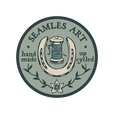Materials
-

Leather
The leather I use for the handles is from bridle leather. Bridle leather is a thicker leather that is treated throughout with oils and waxes which help the leather to stand up to rough outdoor use and horse sweat. This extensive treatment is what gives the leather strength and scratch resistance while allowing it to be soft and supple. The quality and characteristic of this leather is invaluable for the communication between the equestrians hands and the horses mouth.
When cared for properly this leather can last a lifetime. I purchase leather bridles and reins from barns, consignment shops and saddle shops often removing the parts that are still usable but may no longer be appropriate for use with horses. I enjoy the challenge using this leather in new ways and am diligent about the cleaning and conditioning of leather before its use.
-

Fabric
I am drawn to quality fabrics that have texture and richness, often with flowers, patterns or themes. I try to use every inch of the fabric in creative ways to reduce waste. This leads to atypical but creative design placement. While I try to remove as many "age spots" from the material I will leave some if authenticity adds to its interest.
The lower/bottom of each bags is made with either repurposed leather from clothing or a new durable cotton canvas.
While the upper exterior of each bag is reclaimed textiles, the interior is newly purchased. The zippers and hardware (D rings, rivets, etc) are purchased new and the interior of the tote bags are a new high quality Denier fabric that is resistant to water, stains and tears.
Imperfections in leather and its appearance are to be expected. The advantage of using this type of leather is that it will age well, softening and shaping to how it is carried in hand. The colors and protective covering will change over time giving a wonderful patina. Care of the leather with leather cleaners and conditioners is recommended but not necessary as this leather is made to withstand outdoor use with horses.
Cleaning with a saddle soap and conditioner is an easy process and will prolong the life of the leather. I use different products depending upon the needs of the leather but I recommend a Lexol Cleaner and Conditioner product. I prefer this product because it is readily absorbed by the leather and has less likelihood of staining the bag fabric upon contact. Apply products sparingly with soft cloth or sponge or as directed by product.
The leather is secured by either rivets or Chicago screws. The rivots are a smooth cap and will not need adjusting. The screws however should be checked occasionally as they may need to be tightened. This is easily performed using a screwdriver tool.
The bottoms or bases of the bags are made with either a cotton canvas material or leather. This leather I use is garment leather and it comes from leather coats or clothing that I purchase from secondhand stores which are either unsuitable for use or out of style. I use the areas of the coats which are in good condition or I create fabric panels by sewing pieces together. This leather is not a durable as bridle leather and more care is needed. However the aging process of this leather leads to a distressed look with can be desirable. Garment leather is best cleaned using soft cloth and gentle leather soap. The same leather cleaner and conditioner above used sparingly can be effective. There are many informational videos on internet to explore for further information on cleaning leather.
The fabric chosen for the outside of bag is repurposed from textiles such as horse blankets, upholstery remnants, garment leather and vintage supply bags. My goal is to use as much as the fabric as possible while avoiding imperfect areas. This fabric is not perfect however and variations in texture and color are to be expected.
The inside fabric of each bag is new. This fabric is a rip, water and stain resistant adding to its durability and longevity of function.
It is recommended to initially dry wipe or brush areas needed to be cleaned. A cleaner used specifically for fabric may be used although results are not guaranteed. Submerging purse in liquid or adding to washing machine is not recommended.
When reclaiming leather its prior history of care and use is often unknown. Occasionally a white residue or “bloom” will show up on the exterior of the leather. This white waxy residue is called Spew and is often mistaken for mold. It is not mold. Mold is usually green/gray in appearance and may have an odor. Spew is caused by the migration of the oils or fat from within the leather to the surface. This process is often accelerated by changes in temperature or humidity.
If leather spew is present it can be wiped off with a soft cloth or further cleaned using a saddle soap. Unfortunately this spew may return. There are leather spew removal products that can help to mitigate this problem if it persists and is undesirable. Otherwise occasional wiping of leather may be needed.









